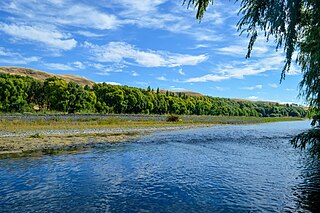Related Research Articles

The economy of New Zealand is a highly developed free-market economy. It is the 52nd-largest national economy in the world when measured by nominal gross domestic product (GDP) and the 62nd-largest in the world when measured by purchasing power parity (PPP). New Zealand has one of the most globalised economies and depends greatly on international trade, mainly with China, Australia, the European Union, the United States, and Japan. New Zealand's 1983 Closer Economic Relations agreement with Australia means that the economy aligns closely with that of Australia. Among OECD nations, New Zealand has a highly efficient and strong social security system; social expenditure stood at roughly 21.5% of GDP.
Telecommunications in New Zealand are fairly typical for an industrialised country.

Hawke's Bay is a region on the east coast of New Zealand's North Island. The region is named for Hawke Bay, which was named in honour of Edward Hawke. The region's main centres are the cities of Napier and Hastings, while the more rural parts of the region are served by the towns of Waipukurau, Waipawa, and Wairoa.

The culture of New Zealand is a synthesis of indigenous Māori, colonial British, and other cultural influences. The country's earliest inhabitants brought with them customs and language from Polynesia, and during the centuries of isolation, developed their own Māori and Moriori cultures. British colonists in the 19th century brought Western culture and had a dramatic effect on the indigenous inhabitants, spreading Western religious traditions and the English language. Over time, a distinct Pākehā or New Zealand European culture emerged.

New Zealand literature is literature, both oral and written, produced by the people of New Zealand. It often deals with New Zealand themes, people or places, is written predominantly in New Zealand English, and features Māori culture and the use of the Māori language. Before the arrival and settlement of Europeans in New Zealand in the 19th century, Māori culture had a strong oral tradition. Early European settlers wrote about their experiences travelling and exploring New Zealand. The concept of a "New Zealand literature", as distinct from English literature, did not originate until the 20th century, when authors began exploring themes of landscape, isolation, and the emerging New Zealand national identity. Māori writers became more prominent in the latter half of the 20th century, and Māori language and culture have become an increasingly important part of New Zealand literature.
Meridian Energy Limited is a New Zealand electricity generator and retailer. The company generates the largest proportion of New Zealand's electricity, generating 35 percent of the country's electricity in the year ending December 2014, and is the fourth largest retailer, with 14 percent of market share in terms of customers as of December 2015.

Corbans Wines was one of New Zealand's oldest wineries, established in 1902 by Assid Abraham Corban, a Lebanese immigrant who had arrived in New Zealand ten years earlier. Corbans Wines grew to become the second largest producer of wine in New Zealand, until they were purchased by their largest competitor Montana Wines in 2000. Following several takeovers of Montana by Allied Domecq and then Pernod Ricard, the Corbans brand was spun off in 2011 and is now owned by Lion.
The Todd Corporation is a large private New Zealand company with a value of $4.3 billion, owned and controlled by the Todd family and headquartered in Wellington, New Zealand. The corporation is currently led by board chair, Nick Olson, and group chief executive officer, Evan Davies. The corporation employs 800 individuals at 10 locations in New Zealand, Australia, and Canada including four on the executive team. The board of directors has seven members.

New Zealand is an island country in the southwestern Pacific Ocean. It consists of two main landmasses—the North Island and the South Island —and over 700 smaller islands. It is the sixth-largest island country by area and lies east of Australia across the Tasman Sea and south of the islands of New Caledonia, Fiji, and Tonga. The country's varied topography and sharp mountain peaks, including the Southern Alps, owe much to tectonic uplift and volcanic eruptions. New Zealand's capital city is Wellington, and its most populous city is Auckland.
Carter Holt Harvey Limited is a privately-owned New Zealand–based company controlled by Rank Group Limited, the corporate vehicle of the country's richest man, Graeme Hart. Based in Auckland, New Zealand, the company has three main divisions: Woodproducts New Zealand and Woodproducts Australia, which are both major Australasian manufacturers of wood-based building products; and Carters, a New Zealand chain of trade-focused building supply stores.

Kauri gum is resin from kauri trees, which historically had several important industrial uses. It can also be used to make crafts such as jewellery. Kauri forests once covered much of the North Island of New Zealand, before early settlers caused the forests to retreat, causing several areas to revert to weeds, scrubs, and swamps. Even afterwards, ancient kauri fields and the remaining forests continued to provide a source for the gum. Between 1820 and 1900, over 90% of Kauri forests were logged or burnt by Europeans.

The Tutaekuri River flows eastward for 99.9 kilometres through the Hawke's Bay Region of the eastern North Island of New Zealand into the Pacific Ocean. It starts in the Kaweka Range roughly 50 kilometres north-east of Taihape, and reaches the sea just to the south of Napier, where the Ngaruroro and Clive Rivers join it.

In New Zealand, agriculture is the largest sector of the tradable economy. The country exported NZ$46.4 billion worth of agricultural products in the 12 months to June 2019, 79.6% of the country's total exported goods. The agriculture, forestry and fisheries sector directly contributed $12.653 billion of the national GDP in the 12 months to September 2020, and employed 143,000 people, 5.9% of New Zealand's workforce, as of the 2018 census.
Vietnamese New Zealanders are New Zealanders of partially or full Vietnamese ancestry.

Chile–New Zealand relations are the diplomatic relations between the Republic of Chile and New Zealand. Both nations are mutual members of the Asia-Pacific Economic Cooperation, Cairns Group, OECD and the United Nations.

Hannahs is a New Zealand footwear retail company.
The history of the banking sector in New Zealand dates back to the early days of European settlement in the country. Over the years, the banking industry has played a vital role in supporting economic growth and development, providing financial services to individuals, businesses, and the government. This article explores the significant milestones and transformations in the history of the New Zealand banking sector.
References
- 1 2 3 Hawke, Gary (28 September 2011). "Chase Corporation – Large companies". Te Ara Encyclopedia of New Zealand. Retrieved 20 May 2012.
- ↑ Hawke, Gary (12 May 2011). "6. Large companies, 1980 to early 2000s – Large companies". Te Ara Encyclopedia of New Zealand. Retrieved 20 May 2012.
- ↑ Gaynor, Brian (15 January 2011). "Time for young to take lead in business". The New Zealand Herald. Retrieved 21 May 2012.